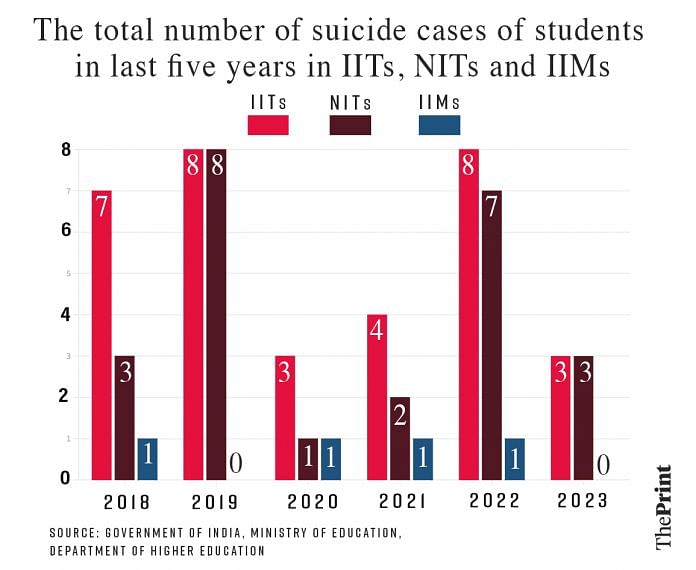New Delhi: As many as 33 students at various Indian Institutes of Technology (IITs) from across the country have died by suicide since 2018, Minister of State for Education Subhas Sarkar told the Parliament Wednesday. The IITs accounted for the maximum number of student suicides among the three institutes for which data was presented by Sarkar, the other two being the National Institutes of Technology (NITs), which reported 24 such deaths in this period, and the Indian Institutes of Management (IIMS), with four such deaths, according to the minister.
The Ministry of Education data becomes even more significant, as it comes in the wake of three incidences of student suicides at IIT-Bombay and IIT-Madras in a month.
Responding to a query by Congress MP L. Hanumanthaiah, Sarkar cited academic stress, family and personal reasons and mental health issues as reasons for the deaths.
“The higher educational institutions take various steps, such as conducting workshops/seminars on happiness and wellness, regular yoga sessions and induction programmes,” Sarkar told Parliament.
He added that the institutions also focus on extracurricular activities, including sports and cultural activities and assign one faculty adviser per 10 students to help with their academics and monitor their progress.
“They also appoint student counsellors for overall personality development of the students, especially those under stress. Further, students, wardens and caretakers are sensitised to bring to notice the signs of depression in fellow students to the authorities so that timely clinical consultation may be provided”, Sarkar told Parliament.
The minister in his response also highlighted various initiatives undertaken by the ministry to counter student-suicides, including peer-assisted learning and introduction of technical education in regional languages to ease academics-related stress.
“The Government of India initiative, MANODARPAN, covers a wide range of activities to provide psychological support to students, teachers and families for mental and emotional well-being during the Covid outbreak and beyond,” Sarkar said.
He added: “The Ministry has also advised the institutions to make the system more robust that would include prevention, detection and remedial measures for addressing possible cause of suicides.”
According to National Crime Records Bureau data, student suicides saw an increase of 4.5 per cent in 2021, attributed in a large measure to the Covid pandemic and related anxieties. In December 2021, Union minister Dharmendra Pradhan had told the Parliament that 34 IIT students had died by suicide since 2014.
Also Read: 11,050 teaching posts vacant in central higher education institutes — DU, IIT-Kharagpur top list
Recent student suicides at IITs
Sadly, the first three months of 2023 have already seen three student suicides at IITs.
While 20-year-old V. Vaipu Pushpak Sree Sai, a third-year B Tech student at IIT-Madras, was found unconscious in his hostel room Tuesday and later declared dead by the hospital authorities, Stephen Sunny, a research scholar, was found dead in his hostel room on 13 February.
The same month, at IIT-Bombay, 18-year-old Darshan Solanki, allegedly died by suicide by jumping off the seventh floor of a campus building on 12 February. Darshan’s family, who is from a backward community, had alleged that he was ostracised because of his caste.
While students at IIT-Madras have spoken of working under stress, following the two deaths on campus, and demanded better mental health help, Darshan’s death reignited the conversation about the prevalence of caste-based discrimination at some of India’s most-premier institutions.
(Edited by Richa Mishra)
Also Read: Overworked doctors, stressed students: How delay in NEET schedule every year is exacting a cost



